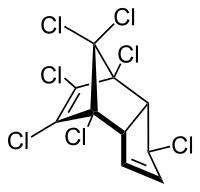
Figure: Molecular structure of cis-Chlordane
ALS offering for Chlordane testing
ALS offering for cis-Chlordane and trans-Chlordane testing
|
Matrix |
LOQ |
Sample volume |
|
Soil |
0.01 mg/kg DW |
10 g |
|
Sediment |
0.01 mg/kg DW |
10 g |
|
Water |
0.01 µg/L |
0.5 L |
Overview
Chlordane was used as an insecticide between the late 1940’s and the late 1980’s. The main application of Chlordane was against termites in the US but it has also been used on domestics lawns and gardens and in the agricultural industry.
Chlordane is not a single compound and technical grade Chlordane consists of nearly 150 different molecules. Two of the main constituents are cis- and trans-nonachlor often included in analytical suites instead of or in addition to Chlordane
Chlordane was included in the original “Dirty Dozen” under the Stockholm convention.
Toxicity
Chlordane is highly toxic to fish. Exposure to Chlordane has shown a negative effect on liver, nervous system and digestive system in humans. The above mentioned trans-nonachlor is more toxic than the technical mixture while the cis-isomer is less toxic.
Animal tests shown that Chlordane is a highly potent carcinogen, however it is currently “not classifiable” with regards to cancer in humans.
Table: International threshold values for Chlordane
|
Country |
Matrix |
Limit |
|
The Netherlands |
Soil |
0.00003-4 mg/kg DW |
|
Sweden |
Sediment |
0-0.3 µg/kg |
|
The Netherlands |
Water |
0.000002-0.2 µg/l-1 |
1. VROM (2000) Streefwaarden en interventiewaarden bodemsanering. Staatscourant 24 february 2000/39. Limit depending on classification
2. Swedish EPA report 4914. Limit depending on classification


